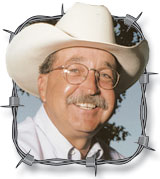Afew weekends ago Pat and I went down to Duncan, Okla., to a literary festival. Duncan is about 80 miles south of Oklahoma City on Highway 81, it's a neat farm/ranch community that straddles the Chisholm Trail. The town has a wonderful civic center for such events, as well as a historical museum of the trail drives.
This had to be one of the prettiest falls for color in years. Most all the country from Dyersberg, Tenn., to Duncan, Okla., I've traveled. It all looks hand painted. The sumac bushes, which usually turn color in August, during the hot dog days of summer, were bright red this late. According to an Indian herb book in my library those berries will treat some male disorders. I don’t suggest you turn into home pharmacists and experiment with such remedies. Since I was a little boy I've always heard the sumac's fruit was poisonous.
But I learned from my co-op electric co-director, Jerry Bolinger, sumac berries must not be toxic to bears. A large male black bear began harvesting them under Jerry's sumac tree one morning during hunting season. In south Madison County, Jerry was high up in a stand with his bow and arrow waiting for a shot while the bruin was harvesting the sumac berries by the mouthfulls on the ground floor. Mr. Bear never got into his shooting sight, but made several trips back and forth around the tree's base, up the hill and back. All the time Jerry had to stay still, so not to draw his attention or scare him off.
When Jerry finally got his chance to pull back his arrow – I could not have stayed up there that long waiting – he drove the arrow through the bear’s body and nine inches into the ground. The male weighed, if my memory is right, 360 pounds, and only went a few steps after being shot to lay down and expire. Now it’s great to shoot such a trophy but I think we may need to set up a “Bear Rug Fund” at a local bank for Bolinger. To have “el bear” made into a rug is going to cost close to $1,000.
But what a trophy and what an experience. Congratulations, Jerry, we’re all proud of your hunt.
My first experience with the black bear was down on the ranch I owned with Monty and Sumner Smith in south Washington county. The Arkansas Fish and Game had released a pair of bears the winter before we bought the place that came I think from the Minnesota Game department in exchange for wild turkey eggs. This was in 1960, and everyone in those days was from scared to smiling about their release. The bear sign I saw, but never a bruin for several years.
Then a young man who later became a Fayetteville police officer was out deer hunting and stopped off at the house, telling Pat and I about his breathtaking experience over meeting a huge black bear. Years went by and I never saw him. Until one December day I was counting locust fence posts a man had cut and stacked on the shares with us. Bright and sunny, I heard a dog trailing something and decided to sit down and wait to see what he was after.
Soon a grown bear with lots of rusty red fur on his back came loping through the field under me. He stopped, listened to the dog and then went loping on out of sight. When the red bone hound arrived, I wanted to tell him he’d be better off chasing a car than that bear – but I let him go. I had finally seen one of the Signal Hill Bears.
But my best bear story is about a neighbor down there at the ranch. One spring my neighbor was out hunting morels, and he had loaded two seven-gallon plastic buckets with them, one in each hand, looking hard at the ground in the bottom of one of those deep canyons down by Devil’s Den for more.
When he happened to raise his gaze up, not 30 feet from him, standing upright, was a large male black bear. My neighbor tried hard to swallow his adam’s apple telling me the story, when I asked him what he did next.
“I gave him all them mushrooms and I ran lickety-split up that bluff to my truck, and I sat for a long time in the cab with the windows rolled up, thanking the good Lord for delivering me from that bear.”
May all your hunting experiences be as good as Jerry’s. See you next issue.
Western novelist Dusty Richards and his wife Pat live on Beaver Lake in northwest Arkansas. For more information about his books you can email Dusty by visiting www.ozarksfn.com and clicking on 'Contact Us' or call 1-866-532-1960.






